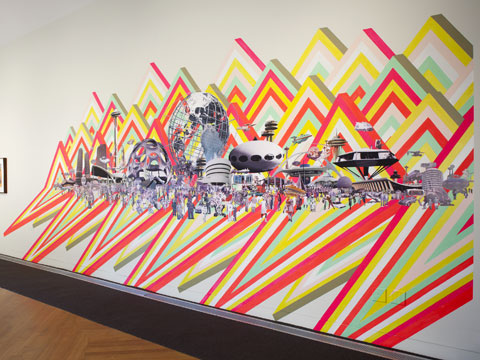
RETRO FUTURE Natalie Lanese’s collage is a super-charming, optimistic, early-Kennedy-era,
Disneyland view of Tomorrowland. |
In "Wall Works" at the deCordova Sculpture Park and Museum, curatorial fellow Lexi Lee Sullivan attempts to corral a trend in art today that spans graffiti and interior decoration. Also on display are the kind of minimalist primary structures that nudge you to be more aware of the spaces around you. You could describe much of what the six artists have made as murals, but that word has come to seem too old-fashioned to describe the erudite snazziness they're aiming for. Calling them installations doesn't feel apt either, because this stuff tends to be only slightly sculptural. So we'll have to settle for "wall works" for now.
Retro Future by Natalie Lanese of Brooklyn is a collaged scene of real astronauts and Hollywood spacemen amidst futuristic architecture pasted atop an array of psychedelic, striped triangles. Part of the fun is in identifying the images: the Jetsons, Michael J. Fox in Back to the Future, real astronauts and rockets, Chicago's Marina City, New York's Guggenheim Museum, Star Trek, Futurama, Disney's Space Mountain, the robot from Lost in Space. Stylistically it recalls Martha Rosler's Vietnam-era collages but without her pointed satire, or heft. Except for a glimpse of Charlton Heston shoving through a crowd in Soylent Green, it's a super-charming, optimistic, early-Kennedy-era, Disneyland view of Tomorrowland.
Alison Owen, who decamped from Providence to Brooklyn over the past year or so, mixes minimalist design, feminist politics, and pretty decoration. She generally begins by sweeping and mopping up a gallery and using the dirt and mop water to paint decorative patterns across the walls that look gilded. At deCordova these patterns become a "wallpaper" of gold flowers and fish scales that begin and then trail off, leaving lots of white space. Owen stretches strings around nails to create illusory picture frames that she echoes with actual gold-painted picture frames. Formally, the elegant, airy installation speaks of visual perception — what's real and what's illusion — while underneath it murmurs of women's work and beauty.
Cambridge artist Caleb Neelon's Mother Buddha of Infinite Involvement is a giant abstracted lady straddling the gallery doors done in a style inspired by illustration, folk art, and daycare-center murals. She has a half-green, half-blue head, a patchwork coat of stained plywood and pressboard, and black sleeves flecked with rainbow-hued diamonds. Up close, Neelon's rendering is a bit wonky, but it charms from a distance. The big figure wears buttons: "She who laughs, lasts," "If you're not having fun, you're doing it wrong," "Will work for peace," "Well-behaved women seldom make history." It seems both an homage to the crunchy, activist ladies of Greater Boston as well as a satire.
The other works here fizzle. Mary Temple of Brooklyn has wowed in recent years with lovely and mysterious trompe l'oeil wall paintings of imaginary sunlight seeming to shine through trees and windows into galleries. Here she instead offers a desk with forms inviting you to share a secret that someone else told you. Every half hour a guard collects the submissions and reads them at the wall and you're supposed to be able to hear the voice on the other side of the room due to the architecture's parabolic arch. But I couldn't make out anything he said, and the idea feels stale after PostSecret. Chalk it up to the difficulty of an artist trying to come up with something new after having previously hit upon such a singular, amazing effect.
Read Greg Cook's blog at gregcookland.com/journal.